Kate Meadows's Blog, page 3
February 29, 2024
How and Why to Craft a “Why I Write” Statement
NOTE: I am a proud affiliate of some of the products I talk about, and I receive a small commission from each book sale.
Have you ever asked yourself this question:
Why do I write?
More importantly, have you ever attempted to answer it?
If you’ve been around me long enough, you know I am a huge proponent of taking the time to get super clear on why you write and turning your answer into a overarching mission/value statement to keep you on a steady writing path.
Writing is lonely work. And it often lacks validation. How often do you talk to others about a story draft you’re writing? Conversely, how often do you question the worth of your writing, whether your writing is any good, whether anyone will care to read it?
This is where your “Why I Write” statement comes in.
When you take the time to get clear on why you write and why writing is such a necessary and important part of your life, you are setting yourself up for future confidence and courage as you move forward in your writing goals. A “Why I Write” statement keeps you grounded and sure in the writing projects you pursue.
Let me explain.
The first time I posed this question to myself – “Why do you write?” – my heart started beating a little harder. That’s because I had SO MANY answers – answers that were fuzzy and vague at first. I write to make a difference. I write because I have something to say. I write to figure out what I think about something.
Blah blah blah.
I realized I felt daunted by the question because, while I had many answers, none of my answers were crystal clear from the get-go. It doesn’t really work to use the statement, “I write because I have something to say” as a guide for your writing endeavors.
We all have something to say.
So what made my drive to write important, specifically?
It took some digging. It took some messy brainstorming and word-dumping on the page.
But as I leaned into the question and started to go deeper with my answers, a clearer mission started to emerge. I not only began to realize more clearly why I write; I began to see how a mission statement around my writing could be a rudder for my creative pursuits. I could hold up any story idea/ambition I had to that mission, and if the idea fit with my mission, I had permission from myself to pursue it. If it did not fit with my mission, I did not pursue it.
For example, through exploring the “why I write” question, I realized more clearly how important the creative nonfiction genre is to me and how writing in other genres does not excite me. This helped me to narrow my writing focus to creative nonfiction. I also knew through experience (a lot of messy first drafts) that writing was often a safe and creative way for me to explore how I fit within a larger story or how I really felt about a particular event or person.
As I continued to explore the question, I also realized how important it was to acknowledge the messiness of the process and to get comfortable with creative chaos. The creative process is like a wild animal sometimes; it takes over and you can either try to tighten the reins and control it or let it lead.
 In the end, my “Why I Write” statement ended up being about 800 words. In it, I admitted the fact that writing is scary and I often feel vulnerable on the page. I latched on to comforting words of David Bayles and Ted Orland, in their book, Art & Fear: Observations on the Perils (and Rewards) of Artmaking.
In the end, my “Why I Write” statement ended up being about 800 words. In it, I admitted the fact that writing is scary and I often feel vulnerable on the page. I latched on to comforting words of David Bayles and Ted Orland, in their book, Art & Fear: Observations on the Perils (and Rewards) of Artmaking.
“Art is like beginning a sentence before you know its ending. The risks are obvious: you may never get to the end of the sentence … or having gotten there, you may not have said anything.”
In the process of writing my “Why I Write” statement, I realized that I often write to come to terms with something. The “Why I Write” statement is itself a coming to terms with the question. I allowed my struggle to be clear. I admitted that it’s hard. I admitted that the creative process is chaotic.
Somehow, getting that out felt like a sort of permission. It’s okay that it’s hard. It’s okay that we don’t have all the answers right from the get-go.
As it turns out, scores of writers have answered this question in their own rite, in their own “Why I Write” manifestos.
George Orwell believed that writing was part of his true nature. He couldn’t help but write. The real question became what to write and why. He found himself writing politically motivated novels because it connected his drive to write with a larger sense of purpose. Otherwise, his writing felt lifeless.
You might be like Stephen King, who writes “for the pure joy of the thing.” (His book, On Writing, is a must-read for any writer, in my opinion!)
Clearly, there are as many answers to “Why I Write” as there are people who take a stab at the question. Coming up with your own answer can seem futile. It can feel pointless as you grasp for words and attempt to put coherent, meaningful thoughts on the page.
But if you stick with it, I think you’ll find that establishing a solid answer will give you a greater sense of purpose as a writer. It can fuel motivation like it did for George Orwell, or it can offer a sense of clarity like it did for Joan Didion. Allow yourself the space to explore why you write, and you begin to develop a road map, a mission statement for your writing as a whole.
If you’re ready to pursue your own “Why I Write” statement and you would like some support, feel free to check out my Writing Craft Talk on it here. You’ll come away with your own “Why I Write” piece – and you’ll have an opportunity to seek feedback on it if you wish.
When you can confidently assert what makes you a writer and boldly state why you write, the words and the ideas you put out there will have a clearer sense of direction. And you can move forward in your creative pursuits with confidence, knowing you have a darn good reason for why you do what you do.
February 7, 2024
On a scale of 1-10, where is your creative energy?
I always find a new year to be a time of tremendous excitement and motivation when it comes to my writing goals and creative projects. But I know not everyone feels that way, and outside circumstances often have a tremendous bearing on the trajectory of our creative lives.
That’s why I recently posed this question to my newsletter and social media followers and webinar attendees:
On a scale of 1 to 10, with 10 being the highest, where is your creative energy coming into the New Year?
Taking a moment to assess your creative energy and what’s driving it (or not driving it) gives you a good baseline for setting your goals for the new year. Perhaps you’ve succumbed to writer’s block or are feeling stuck in the weeds of a creative project and you’re not sure why. Take a moment to think about where your energy and focus is, and ask yourself what is one small step you can take to move the needle on this creative work.
Perhaps you’re flying high and feeling ready to conquer the world with your creativity. Take a moment to ask yourself where you could specifically channel that energy to make the most progress in your creative work.
When I asked, “On a scale of 1 to 10, where is your creative energy coming into the new year?” responses poured in. I collected them into a single document to share with you. You can read them below.
I share these responses to give you a glimpse of the tremendous range of emotion and situations that other writers find themselves in. Together, these responses show that, regardless of where you place yourself on the 1-10 scale, you’re not alone.
Perhaps you’ll resonate with some of these, recognize yourself in one of them, or empathize with a particular situation. At the end, download the Create Energy 2024 Reflection page to answer the question yourself and set a clear and achievable next goal on your creative project, regardless of where you place yourself on the creative energy scale!
Here is what others shared when it comes to their creative energy:
I’d put myself somewhere between 8 and 9 on the creative energy scale. Some of the positivity stems from receiving a grant to finish a project within the next year. Hate to have to pay the [darn] thing back, so yeah, I’ve got the initial energy.
***
I’m at 4. I’m no higher because I’ve been there, done that with the writing-energy thing many, many previous years—and it’s never given me enough momentum to stick with my goals for the long run. At this point, I struggle with learned helplessness.
***
But I’m above 1 because I’ve taken a couple of concrete steps to introduce structure and support into my writing life, and I hope that might make a difference.
***
Right now, I’m a 10, because I’m participating in a “30 Days to First Draft challenge!”
***
I would put myself at about an 8. At the end of 2023 I signed a contract to write another book … The only reason I am not at a full 10 is that I still don’t have a lot of motivation to write posts to my blogs with any regularity.
****
My creative energy is about a 6. Lots of stuff to say but not much time to say it!
*****
My creative energy is at a 7. I hope I can plan and finish a book this year!
*****
My creative energy is around an 8. I’m working on memoir.
***
My creative energy is about a 5. I’m feeling overwhelmed, which leads to procrastination. But I hope to finish my book in 2024.
****
I’m at a 3 because my day job for a paycheck takes a lot of my energy.
***
I’m at a 2 because I am just getting started.
****
I would put myself at a 4. I am refocusing after some time away from writing.
****
I’m at a 10 because I’ve got energy and clear goals!
****
I would say 6. I have projects I’m working on but I’m totally squeezing that work into spaces between life and work stuff, blah blah blah.
****
I’m at a 6. I have ideas, but finding time is the problem.
****
I’d put myself at an 8 because I have too many projects. Yet, I am working on them.
****
I’m at 7. I just finished my degree and am super excited to have time to write and have fun with it again!
****
I’m at a 4 or 5. My creative energy has been good, but there’s been a lot of external things getting in the way.
****
I’m on fire – probably a 9. Writing every day has been HUGE!
So, dear reader, where would you place yourself on this “creative energy scale?” Which of responses do you most resonate with? Or is your response something entirely different? Feel free to share in the comments or email me directly at kate@katemeadows.com. And, don’t forget to download your own 2024 Creative Energy Reflection here.
Happy writing!
January 4, 2024
What’s Your Number-One Writing Goal for 2024?
It’s 2024. Happy New Year! The new year marks a new beginning, and as a writer roiling with new creative energy, I’m curious. What primary goal have you set for 2024?
To be more specific, what is your number-one writing goal for this new year?
Most of us have multiple goals as a new year gets underway, and as a writer, I will say I have multiple writing goals. But if I were to declare ONE and focus on it above all others, I know what it would be: upping my submissions game to magazines and literary magazines.
That’s not quite specific enough, though. What would upping my submissions game look like, exactly?
For me, it’s getting into a routine, a predictable schedule, of regularly submitting my work and ideas to publications. By “regularly,” I mean every week. And I mean every day, Monday through Friday.
Seeing those words on the page – EVERY DAY – makes my eyes bulge a little. Holy smokes! That’s a lot of submissions!
Or is it?
Rather than track my submissions by the number each day, I plan to track my submissions by the time I spend each day, allowing myself a little time each day to research outlets and send my work out there. The more I think about this goal and lay it out, the more excited I get.
Goals are like that: The more specific we get with them, the more excited we become. Why? Because we can more clearly see what we’re trying to accomplish.
As you lay out your writing goals for 2024, I encourage you to think critically. Give your goal setting the time it deserves, and get specific.
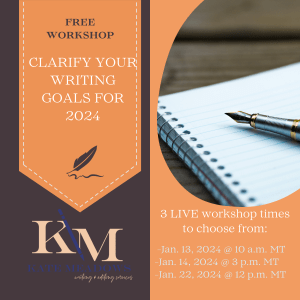 If you’d like some guidance, then I invite you to attend my free webinar, “Clarify Your Writing Goals for 2024.” I’ll host this webinar three times, on three different days and at three different times, to accommodate schedules. When you register, you can choose from the following dates/times:
If you’d like some guidance, then I invite you to attend my free webinar, “Clarify Your Writing Goals for 2024.” I’ll host this webinar three times, on three different days and at three different times, to accommodate schedules. When you register, you can choose from the following dates/times:
Sat. 1/13 @ 10 a.m. MT
Sun. 1/14 @ 3 p.m. MT
Mon 1/22 @ noon MT
The sessions will be recorded, so even if you can’t make it live, you’ll be able to access the recording when you have time.
In “Clarify Your Writing Goals for 2024,” you will set a writing road map for the coming year by identifying exactly how you want to grow as a writer over the next 12 months. You will identify potential hurdles, brainstorm with me and other attendees ways to overcome those hurdles and walk away with a step-by-step plan for how to accomplish your specific writing goals for 2024.
You’ll walk away with a clear outline, knowing exactly what your next step is to meeting your 2024 writing goals. You’ll have tools in your toolbelt and the confidence and sense of clarity to make 2024 your best writing year yet!
Your writing goal may fall into one of these categories:
Where do you fall? What is your number-one writing goal for 2024? I would love to know, and I would love to support you as you move forward with your writing. Share your goal with me, and let’s inspire each other on this creative journey!
December 3, 2023
Upcoming Events and Opportunities, December 2023
&
12/20/23
Get your writing done in these regularly scheduled virtual work sessions! We gather on Zoom on the first and third Wednesdays of the month. We spend 5-10 minutes talking about our writing projects and what we’re working on, and then we’ll get to the actual work of writing! The idea behind a write-in is that it provides structure and accountability for a craft that is all-too-often lonely and lacking in peer support. We’ll write for an hour or so, and then reconvene for a quick de-brief. Participate in one or both monthly sessions.
Sign up for monthly reminders and receive the Zoom link here.
12/28/23 | 4 p.m. MT | SUBMIT IT! (free)Join me in this free monthly online meetup for writers who want to learn more about submitting their work to literary magazines and publishers. Each session will open with a Q&A or brief talk about something related to the submissions process. Then we’ll break out and spend an hour drafting query letters and … you guessed it … submitting our work! We’ll close each session by coming back together for a brief follow-up.
Sign up for monthly reminders and receive the Zoom link here.
 December 1-31 | Seeking Founding Members of NEW StoryCore Writing Community
December 1-31 | Seeking Founding Members of NEW StoryCore Writing Community 
A new writing community for writers who are committed to making regular progress on their creative work, STORYCORE is a place where writers can come for accountability, inspiration and networking. Through December, join as a Founding Member of my new writing community and receive 50% off lifetime access. As a Founding Member, you’ll receive questions from me via email as I build out the community.
When I open the community to the public in 2024, the membership price will be $37 per month. As a founding member, you’ll pay just $18.50 per month, for as long as you remain in the community.
October 30, 2023
Maybe Stories Do Matter: Some Writing Lessons from Kate DiCamillo
Author Kate DiCamillo remembers being on a plane shortly after terrorists toppled the World Trade Towers on Sept. 11, 2001. She was in the early stages of working on a children’s novel called The Tale of Despereaux.
The man sitting next to her on the plane turned to her and said, “Scary times, huh?”
She said yes.
Sometime during the flight, the man asked her what she did for a living.
She told him she was a writer.
When he asked her what she wrote, she flushed. It seemed wildly superfluous to tell a stranger she was working on a fairytale about a mouse who falls in love with a princess, days after thousands of lives were lost in one of the most brazen acts of terrorism in history.
“It doesn’t matter,” she finally said. “Stories don’t matter now.”
This is how DiCamillo introduced herself in Deadwood, SD, recently, at the annual South Dakota Book Festival. She read from an essay she had published in The Washington Post three days earlier, marking the 20th anniversary of her bestselling book, The Tale of Despereaux. The essay recounted her story of setting out to write a fairy tale, on the request of her friend’s 8-year-old son, about “an unlikely hero with exceptionally large ears.” About 50 people gathered in a low-ceilinged basement of a hotel on Main Street to hear her speak and ask her questions about writing. 
The Tale of Despereaux begins this way: “The world is dark and light is precious. Come closer, dear reader. You must trust me. I am telling you a story.”
Light has everything to do with writing for DiCamillo – and for her audience: children and their parents. According to a recent profile on the author in The New Yorker, DiCamillo turns on a porch light every morning before sitting at her writing desk. The light lets her early-bird friend and neighbor know she is awake and at work on her writing.
“I feel like we all have to push against the darkness however we can,” DiCamillo told writer Casey Cep for The New Yorker piece. “For me, it’s doing my work, writing stories that let children feel seen and to know they’re not alone in whatever they’re going through.”
There is no light in the sky when DiCamillo begins her daily writing routine. At her talk in Deadwood, she told the audience that she gets up at 4:30 every morning to write. This is a method for beating her internal critic to the punch: she writes early in the morning before the critic – and the world around her – wakes up. She commits to writing 2 pages per day.
“I found that if you sat down and wrote 2 pages a day, you would have a novel in a year,” she said.
Her novels, she readily admits, are always smarter than she is.
The seed of her first novel, Because of Winn Dixie (published in 2000), came to her quite simply one night shortly before she fell asleep; she heard a girl’s voice in southern accent: “I have a dog named Winn-Dixie.” And the muse led from there.
DiCamillo says she doesn’t know where a story is going when she starts. She likens the writing process to walking down a dark hall with a slit of light at the end, beneath a closed door.
As she was working on The Tale of Despereaux, she kept a timeline above her desk about Despereaux, which she referred to often. Even so, “I was so afraid as I was telling it,” she told us, “because I didn’t know where it was going.”
And there was a time, early on in the creating of Despereaux, that she almost gave up. The twin towers had crumbled and so, too, had the souls of thousands on American soil and beyond. How could a thing as trivial as a story have any meaning after that?
But that man sitting next to her on the plane pointed her back to the light. At baggage claim, he tapped her on the shoulder. As she recounts in her Washington Post essay, he said, “Hey, good luck with your mouse.” ‘Then he said, “Maybe you’re wrong. Maybe stories do matter now. Have you thought about that?”’ 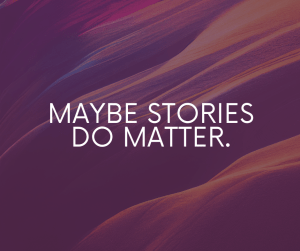
To date, DiCamillo’s books have sold more than 44 million copies.
The Tale of Despereaux is this year’s Young Reader’s One Book for South Dakota. Each year, the South Dakota Humanities Council selects one book for young readers across the state to read. Copies of the book are given to third graders throughout the state.
Today, at book events, DiCamillo often instructs children to “go home and read to your adult.”
“When you write for kids,” she told us at the event in Deadwood, “I feel like I need to end each story with hope, because hope is what kids need.”
(Note: This post contains affiliate links.)
September 23, 2023
What IS a Write-In?
You’re a writer.
That means you write.
Right?
Writing is hard. Creative writing is hard. The ideas burst forth at inconvenient times. Life gets in the way of us flexing our creative muscles. More often than not, it’s easier to throw in the towel, to say, “Not today, muse!”
I know I need to commit to my writing, and I know that means showing up regularly. I also know I am not the only one who struggles with this. One way I am facing the challenge is through accountability and a new event I’m hosting twice monthly on Zoom – a write-in.

Photo by picjumbo.com on Pexels.com
What is a write-in, you say?
A write-in (also known as a co-write) is an event that brings writers together with the goal of each participant making progress on a personal writing project. These events can take shape in different ways. Some are virtual, and others are in-person. Some last for two hours while others last for one. Some involve writing prompts while others do not.
Regardless of the structure or the location (physical or virtual), the main purpose of a write-in is to offer community and accountability to writers who want to make progress on their writing. It is a way to stay committed and on track with our creative projects, despite the noise of life.
Recently, I started hosting two free virtual write-in events each month. Here’s what happens:
1) We meet on Zoom, at a predetermined, regularly scheduled date/time:
– 1st Wednesday of the month @ 11 a.m.-12:15 p.m.
– 3rd Wednesday of the month @ 6:30-7:45 p.m.
2) We start with a quick check-in. I ask attendees what they brought to work on or what specific goal they have for today’s writing time.
3) Then, we hit the ground (or page) running. I set a timer, and we  write. For an hour. This is QUIET time, time to get your creative work done. Although everyone is working alone, we are alone together, all working on our writing at the same time. THIS is the accountability piece.
write. For an hour. This is QUIET time, time to get your creative work done. Although everyone is working alone, we are alone together, all working on our writing at the same time. THIS is the accountability piece.
4) Since we are on Zoom, you can choose to write with your screen turned on or off.
5) I announce a five-minute “come to a stopping point” warning at 55 minutes in.
6) At the one-hour mark, I call everyone back together on Zoom.
7) We spend 5-10 minutes talking through any highs/lows of the past hour. Everyone establishes their next immediate step in their writing project.
8) We meet again at the next scheduled write-in time.
You might think of a write-in as a power tool for getting your writing done. It is a built-in mechanism to keep you from procrastinating on your work-in-progress. Being present holds you accountable. Writing in community reminds you that you don’t have to go it alone. And hearing from and interacting with other writers during the brief check-in and check-out periods offers added insight into creative processes and often a new way to look at your story.
By showing up regularly for a set amount of time, you are able to meet small, sustainable goals, over and over. That means you will make progress faster on your story. And, you get to be a part of something bigger than you – we come together in a community with a shared purpose.
For anyone who struggles to make writing (as in, their own writing projects) a priority, a write-in might be just the tool you need to set and meet your writing goals – AND finish that writing project!
Writing is lonely work. It has to be. No one can put words on paper quite like you can. But it doesn’t mean that we have to live in a vacuum all the time.
If a write-in sounds like something you might want to be a part of, I would love for you to join us. We meet on Zoom the first Wednesday of the month at 11 a.m. MT and the 3rd Wednesday of the month at 6:30 p.m. MT. You can join both sessions or just one – whatever fits your schedule and interest. Sign up to receive twice monthly reminders here, or contact me if you have questions.
Happy writing!
September 1, 2023
September 2023 Events & Opportunities
 Sept 6 - Write-In, 11 a.m. MT, Zoom Sept 12 - Women in Networking (WIN) presentation, Rapid City, SD Sept 22-23 - SD Festival of Books, Deadwood, SD Sept 20 - Write-In, 6:30 p.m. MT, Zoom Sept 28 - SUBMIT IT! 4 p.m. MT, Zoom
Sept 6 - Write-In, 11 a.m. MT, Zoom Sept 12 - Women in Networking (WIN) presentation, Rapid City, SD Sept 22-23 - SD Festival of Books, Deadwood, SD Sept 20 - Write-In, 6:30 p.m. MT, Zoom Sept 28 - SUBMIT IT! 4 p.m. MT, Zoom Questions? Feel free to reach out! Send me an email at kate@katemeadows.com! Happy writing!
August 21, 2023
Use Lists to Power Your Writing

Do you ever use lists to organize your writing, or to stimulate your creativity? (Or, to be totally boring here, to get better organized?) When I was young, I carried around a book with me that was like my writing Bible. It was called Thinking Like a Writer by Lou Willett Stanek. One of the things I loved most about this book was the author’s suggestion to keep lists as a way of stimulating creativity.
I kept a book of lists. On each notebook page was a different title: ugly words, funny words, interesting names, the funniest thing I saw today, the saddest thing I saw today, words to look up, character traits, etc.
These lists helped me to notice more about the world around me. They motivated me to pay attention. When I was reading, I studied the words with more scrutiny. I found humor in billboards and ugly words on menus. (Ham, for example. What about that word is beautiful?)
Keeping lists helped me to think more critically about everyday aspects of life – characters and settings and interactions that I might someday be able to use in a story somewhere. When I visited a new place, I took in its attributes. I asked myself, “What sets this place apart?” and “How would I describe this place?” and “Where could I use snippets of description about this place in my writing?”
Of course, many of the thoughts and notes I kept simply for a future project. I often didn’t have a place to add a specific description or insert an ugly or funny word. But all of this became fodder – resources and threads of possibilities for future creative projects. With each observation I added to a list, there came a gust of possibility, a spark of hope: Where might this word or this description show up in my future writing?
 When I opened my journal today – the one I am currently writing in – there was another list, on the first page. I titled the list “Words to Keep,” paying tribute to Minrose Gwin’s painfully beautiful historical fiction book, Promise. In the book, a young girl’s mother gives her a “Word to Keep” from time to time, encouraging her to jot it down and learn it. Why? Because the words are powerful. The Word to Keep might be big. It might contain different meanings. It might evolve as the present transitions into history. The mother knew that the possibilities of what her daughter could do with words were endless – and so giving words to her to keep was an incredible gift.
When I opened my journal today – the one I am currently writing in – there was another list, on the first page. I titled the list “Words to Keep,” paying tribute to Minrose Gwin’s painfully beautiful historical fiction book, Promise. In the book, a young girl’s mother gives her a “Word to Keep” from time to time, encouraging her to jot it down and learn it. Why? Because the words are powerful. The Word to Keep might be big. It might contain different meanings. It might evolve as the present transitions into history. The mother knew that the possibilities of what her daughter could do with words were endless – and so giving words to her to keep was an incredible gift.
As writers, we should all have our own Words to Keep. We should have an insatiable hunger to study and use our words well, to grow our vocabulary and examine language from all angles. We should always be curious, asking what words can do – how they can teach, uplift, inspire, illustrate. We should always be asking how words – the words we write – connect us.
A list can be one of the writer’s most important tools. Lists are, after all, collections of words. Keeping lists is a writer’s practice that never gets old. Try it, if you haven’t. And let me know what comes from it.
Do you use lists to stimulate your writing?
May 24, 2023
A Summer of Telling Our Life Stories
A couple of weeks ago, I hosted a webinar about telling life stories – what they are, why they matter, how to tell them. People came to the proverbial table at many points along their journey, with various motivations for pursuing their life stories:
· I have diaries from my mother from the 1930s through the 2010s and want to tell her story.
· I have almost 80 years of life experiences that I keep wanting to write down for my family. Time to get started!
· I want people close to me to know what I went through.
· I lived through times of segregation. It was ugly and I don’t want that time to ever come around again.
· Telling my story helps me to make sense of my own life and experiences.
· I kept journals for 26 years. I want to preserve them electronically.
· My amazing memory. I recall stories my grandmother shared with me when I was a child. I feel compelled to get them out there.
· My late dad wrote his own memoir as a grief exercise after Mom died.
The life stories that people are working on are as complex and varied as humanity itself. Our experiences span generations; they span history.
In the webinar, we addressed some common objections to why people either put off or never share the life stories inside of them:
I’m not that interestingI don’t have a story to tellNo one cares about my story Many people think they are uninteresting, that they lack value, that they haven’t contributed anything all that meaningful to the world.
Many people think they are uninteresting, that they lack value, that they haven’t contributed anything all that meaningful to the world.
But as writers (or want-to-be writers), you and I know different. There is meaning in our stories, wisdom and failure, history and hope. In my work, as both writer and editor, I strive to bring out ordinary people doing extraordinary things. And extraordinary doesn’t have to be world-changing.
We tell stories for many reasons:
To come to terms with somethingTo better understand something or someoneTo preserve historyTo preserve memories (even if people’s memories of the same events differ)To document a family traditionTo honor a place in timeTo satisfy a burning curiosityTo teach a lessonTo entertainTo recount a journeyDo any of these resonate with you?
 If so, I want to invite you to commit to getting your life story down on paper this summer. When I say “life story,” I am using the term broadly. For some, a life story might be a single event or a moment in time. For others, it might encompass a 90-year lifespan. For you, a life story might be three pages. For someone else, it might be 300. Whatever real-life story is in you, consider this your invitation to start getting it down.
If so, I want to invite you to commit to getting your life story down on paper this summer. When I say “life story,” I am using the term broadly. For some, a life story might be a single event or a moment in time. For others, it might encompass a 90-year lifespan. For you, a life story might be three pages. For someone else, it might be 300. Whatever real-life story is in you, consider this your invitation to start getting it down.
Do you need to come to terms with something? Is there someone in your family who you wish you knew more about? Is there a family tradition that might go by the wayside if you don’t preserve it in writing?
At the end of the webinar, I asked the attendees what NEXT STEP they would take TODAY to move their story forward. Here are just a couple of responses:
I will set a calendar date today to go to the park, sit on a hill and continue to list things chronologically and writing a flashback within that time frame.Set time with sister for interview. Write 100-word memory tied to story. I know firsthand the challenges of staying motivated and on track when it comes to creative work. Writing can be a lonely job. It is also full of discoveries, and while that’s exciting, it can also create fear. That’s why I created two opportunities to receive extra support for bringing your life story from idea to completed draft – this summer. And whether you attended the webinar or are just now reading about it for the first time, I want to offer that support to you.
I know firsthand the challenges of staying motivated and on track when it comes to creative work. Writing can be a lonely job. It is also full of discoveries, and while that’s exciting, it can also create fear. That’s why I created two opportunities to receive extra support for bringing your life story from idea to completed draft – this summer. And whether you attended the webinar or are just now reading about it for the first time, I want to offer that support to you.
For a self-paced resource, check out the Life Story Workbook, a five-part downloadable PDF that guides you through every step of the writing process – from collecting notes and research to celebrating when you’ve reached various milestones throughout your project. The Life Story Workbook includes a bonus, 50 Questions for Life Story, which is an excellent tool for both writing prompts and interviews. The Life Story Workbook is available here, for $27.
 If you want to go deeper, I invite you to join my first-ever Summer Story Accelerator, where we’ll work through each of the five steps in the workbook together with one-on-one coaching calls and group implementation sessions via Zoom. You’ll dive deep into:
If you want to go deeper, I invite you to join my first-ever Summer Story Accelerator, where we’ll work through each of the five steps in the workbook together with one-on-one coaching calls and group implementation sessions via Zoom. You’ll dive deep into:
REFLECTING – thinking about the who, what and why of your story, from a wide-angle view.
GATHERING – receiving advice and encouragement for where and how to gather your resources, including from places you may not have even considered.
PLANNING – laying out a plan for the actual writing itself and determining how you’ll track your progress
WRITING – seven weeks of getting the words, the thoughts, the stories down. (And don’t worry. I’ll check in with you during this time for a one-on-one coaching call.)
CELEBRATING – marking your milestones and celebrating like nobody’s watching when you make them! (Everyone in the program will toast to you when you reach those milestones! We’re cheering you on!)
To learn more about the Summer Story Accelerator or to enroll, visit https://www.katemeadows.com/summer-story-accelerator/.
Stories are an act of preservation and communication. We write to communicate. What do you have to say to the world?
Download the Life Story Workbook and sign up for the Summer Story Accelerator today! You’ll be on your way to moving your story toward a completed draft. It’s something you will never regret.
May 2, 2023
Telling Our Life Stories – a free webinar on May 13!
 How many stories are out there, waiting to be captured?
How many stories are out there, waiting to be captured?
Have you ever heard a story from a family member and thought to yourself, someone needs to write that down!
Or is there a story from your own life that you hope to tell … someday?
Norman Vincent Peale wisely said, “If you put everything off until you’re sure of it, you’ll never get anything done.
On Saturday, May 13, at 9 a.m. MDT, I’m hosting a FREE webinar, “Telling Our Life Stories.” It will be a jam-packed hour of exploring the power of story and equipping you with tools and tricks to to preserve and share memories. Together, we’ll think critically about why your stories matter. Stick around until the very end for a special opportunity, and walk away with the tools and the game plan you need to bring your story to life.
There will never be a “perfect time” to get your story down. Come along with me on a journey to get your story on paper. (You can always polish it later!)



